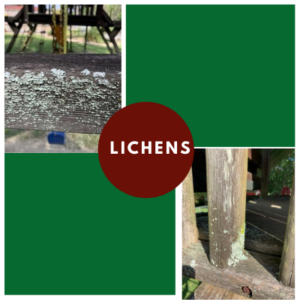Causes And Control For Lichens On Wood

I bought a swing set when my first child was very young. I would guess that it is about 18 years old now. It is made from redwood, which is a naturally durable wood species. Redwood has long been used for exterior products such as hot tubs and decks.
A naturally durable wood species will be much more resistant to biological degradation than a nondurable wood species. However, all wood species will eventually degrade. Over the years my swing set has been attacked by wood degrading fungi, mold fungi (which do not degrade the wood), and carpenter bees.
Each year I would apply a new coat of stain with a water repellent. However, since the flood of 2016 I have not been as diligent. So, I have a new problem growing on the surface of the wood – lichens (pronounced “like-uns”). They are attracted to wet wood and retard the drying process after our frequent rains, which then allows conditions for decay fungi to linger.
There are at least 13,000-17,000 species of lichen living throughout the world. Lichens are typically placed in three main groups based on their body forms and features: crustose (crust-like), foliose (leaf-like), and fruticose (tube or beard-like strands).
A lichen consists of two unrelated organisms, an alga and a fungus. The alga can photosynthesize and provide energy for the lichen. The fungus can obtain water and minerals and protect the algal cells from desiccation. They do not have leaves, stems, or roots, or a waxy outer cuticle to control body water content. Lichens continue to grow during periods when dew, mist and rainwater are present. A summer dry period can cause them to become dormant until the next rainfall.
Lichens thrive in undisturbed sites where little if anything else will grow. They grow on rocks, barren soil and the bark of dead or live trees. Lichens pose no harm to trees and their presence is an indicator of good air quality. Although lichens are tough and can survive in extreme climates, including extreme heat, cold and drought, they are sensitive to air pollution. Because lichens are so pollution-sensitive, they have been used to assess air pollution.
The removal options include pressure washing, scraping, and chemical spray. Pressure washing is effective at removing lichens but should be done carefully so you do not damage the wood. You can also remove lichens with any sort of putty knife or scraper. Careful scrubbing with a stiff brush will remove anything that remains after scraping.
Most products designed to control algae and moss are also effective at killing lichens. A good method is to look for a chemical with the active ingredient potassium soap of fatty acids. Purchase a container that can be connected to your garden hose. These sprays will kill and/or loosen the lichens from the wood. After soaking the lichens with the soapy solution, scrub the wood with a stiff bristled brush and then rinse with water. The final step for all removal methods is to prepare a clean wood surface by removing the lichen particles with a broom or blower. Then, apply a water repellent. I have had best results when annually pressure washing, allow the surface to dry, and then apply a water repellent.
Meet the Author
Dr. Todd Shupe is the President of Wood Science Consulting, LLC. He is a well-recognized expert on wood forensics, wood preservation, wood decay and degradation, and wood species identification. He has a broad background in new product development, quality management, and marketing and sales in both the public and private sectors. For more information please visit DrToddShupe.com.
We welcome your comments below.
Thank you for visiting. We trust that you have enjoyed reading our articles.
Liked this post? Read more below or search for more topics . . .

